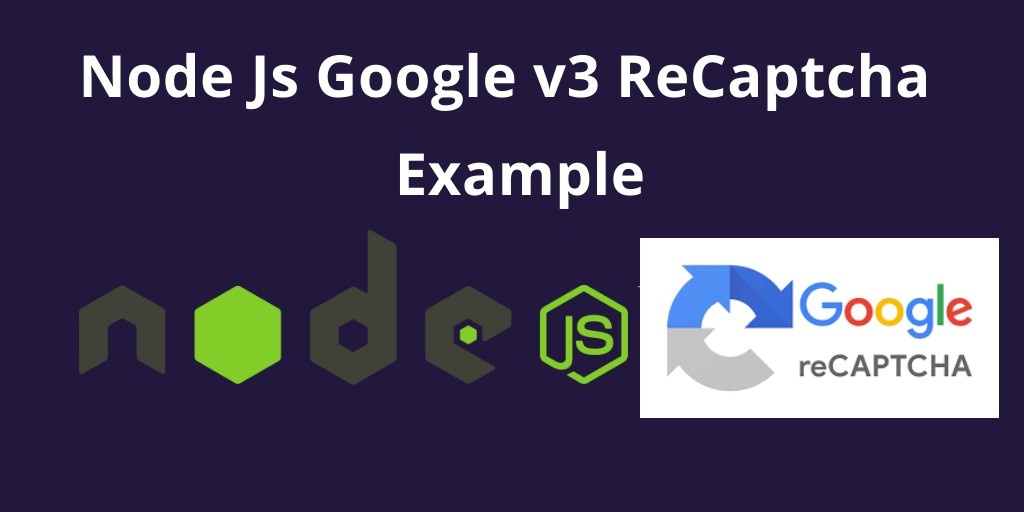Google V3 Recaptcha In Node.js Example Tutorial From Scratch. Here you will learn how to integrate Google Recaptcha v3 in node js forms validation with example. Or add google v3 ReCaptcha security in your node js forms for prevent the computer bots, spammers to enter your website.
In this node js google v3 recaptcha example tutorial, we will use Node.js and express framework to build a Google v3 Recaptcha Security.
1. Get Google reCaptcha v3 credentials
Now, you need to register your site with this URL: https://www.google.com/recaptcha to get the API key and API secret.
Note:- Google Captcha does not natively support the localhost domain so what you need to do is in the text box of the site name, put your local address: 127.0.0.1. That is it.
2. Create a fresh project
Here you need to create project folder and then type the following command into your command prompt (cmd):
mkdir public npm init
We are initializing the package.json file.
{
"name": "googlerecaptcha",
"version": "1.0.0",
"description": "",
"main": "server.js",
"scripts": {
"start": "nodemon server"
},
"author": "tutsmake.com",
"license": "ISC",
"dependencies": {
"body-parser": "^1.17.2",
"ejs": "^2.5.7",
"express": "^4.15.4"
},
"devDependencies": {
"nodemon": "^1.11.0"
}
}
We have written three packages as dependencies, so go to your terminal and type the command.
npm install
3. Create view file in project
Create one file name index.ejs is called views file. In this file, We are using the Bootstrap CSS Framework for this application, so we will include that CSS file in the public folder.
<!-- index.ejs -->
<!DOCTYPE html>
<html>
<head>
<meta charset="utf-8">
<title>Node js Google v3 Recaptcha Example Tutorial</title>
<link rel="stylesheet" href="bootstrap.min.css">
</head>
<body>
<div class="container"><br />
<h1>Google Recaptcha Tutorial</h1><br />
<form method="post" action="/captcha">
<input type="hidden" id="g-recaptcha-response" name="g-recaptcha-response">
<input type="hidden" name="action" value="validate_captcha">
<div class="row">
<div class="col-md-4"></div>
<div class="form-group col-md-4">
<label for="name">Name:</label>
<input type="text" class="form-control" name="name">
</div>
</div>
<div class="row">
<div class="col-md-4"></div>
<div class="form-group col-md-4">
<button type="submit" class="btn btn-success" style="margin-left:38px">Send</button>
</div>
</div>
</form>
</div>
<script src="https://www.google.com/recaptcha/api.js?render=your reCAPTCHA site key here"></script>
<script>
grecaptcha.ready(function() {
// do request for recaptcha token
// response is promise with passed token
grecaptcha.execute('your reCAPTCHA site key here', {action:'validate_captcha'})
.then(function(token) {
// add token value to form
document.getElementById('g-recaptcha-response').value = token;
});
});
</script>
</body>
</html>
To access this page, we need to set up one route in a server.js file.
// server.js
app.get('/', function (req, res) {
res.render('index');
});
Go to your terminal, type following command.
npm start
Go to your browser and type this URL: http://localhost:3000
4. Create server.js and Handle the request at the server-side
Here, we will to do two things. First one is install one HTTP request package called request. So use the following command to install HTTP request package in Node js:
npm install request --save
Second thing creates a server.js file inside your project folder and update the following code into your server.js file:
// server.js
const express = require('express'),
path = require('path'),
bodyParser = require('body-parser'),
request = require('request');
const app = express();
app.set('view engine', 'ejs');
app.use(express.static('public'));
app.use(bodyParser.urlencoded({extended: true}));
app.use(bodyParser.json());
var port = 3000;
app.get('/', function (req, res) {
res.render('index');
});
app.post('/captcha', function(req, res) {
if(req.body['g-recaptcha-response'] === undefined || req.body['g-recaptcha-response'] === '' || req.body['g-recaptcha-response'] === null)
{
return res.json({"responseError" : "something goes to wrong"});
}
const secretKey = "xxxx";
const verificationURL = "https://www.google.com/recaptcha/api/siteverify?secret=" + secretKey + "&response=" + req.body['g-recaptcha-response'] + "&remoteip=" + req.connection.remoteAddress;
request(verificationURL,function(error,response,body) {
body = JSON.parse(body);
if(body.success !== undefined && !body.success) {
return res.json({"responseError" : "Failed captcha verification"});
}
res.json({"responseSuccess" : "Sucess"});
});
});
app.listen(port, function(){
console.log('Server is running at port: ',port);
});
Put the secret key according to your site. If you submit the form with captcha verification, you will get success in response.
Note:- If you do not verify captcha and send the form then, you will get an error in response.




